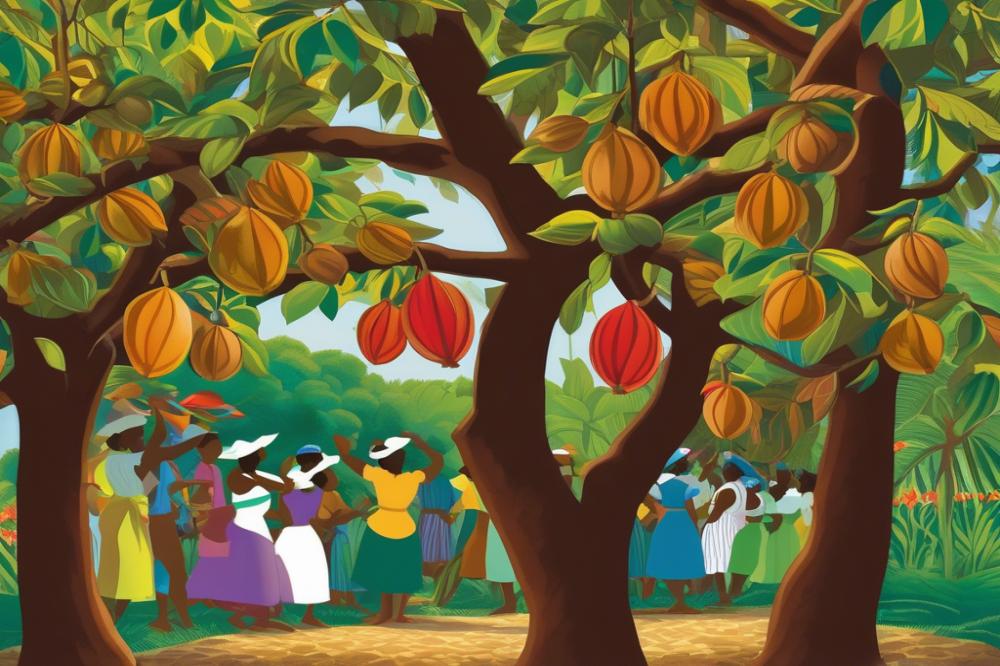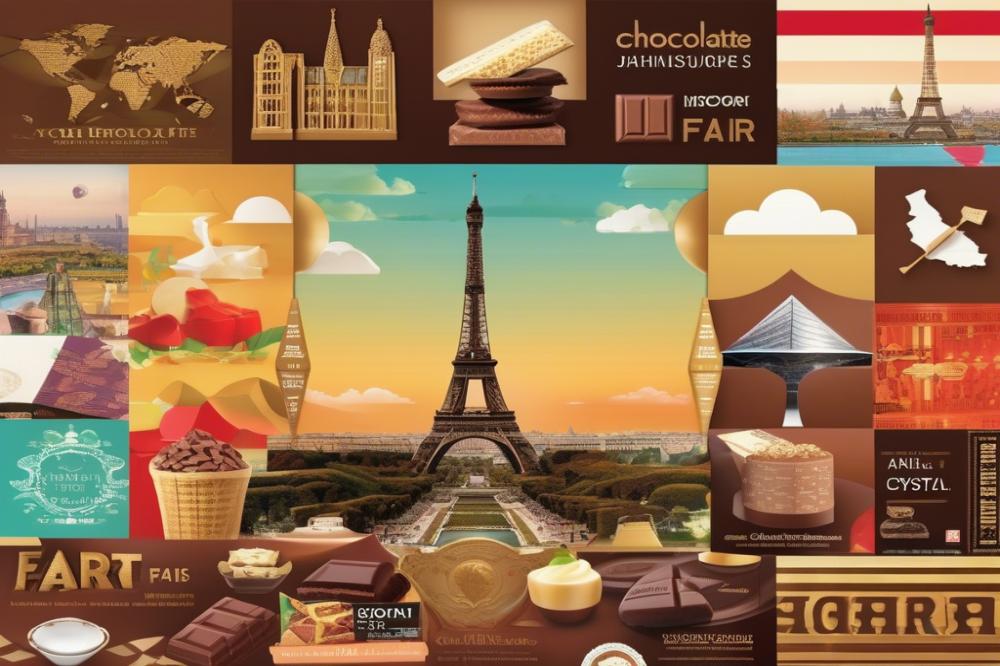How Chocolatebix.com/the-evolution-of-Chocolate-in-south-american-cultures”>World Fairs Popularized Chocolate Globally
Chocolate has a long and rich history. It began as a bitter drink among ancient civilizations in Mesoamerica. The Mayans and Aztecs treasured chocolate, often using it in rituals and for currency. Over time, its culinary history evolved. European settlers transformed chocolate into the sweet treat we know today. This journey showcases the fascinating transformation of chocolate culture over centuries.
globalization played a crucial role in spreading chocolate beyond its origins. As countries connected through trade and exploration, new flavors and styles emerged. This exchange brought about innovations in chocolate production. The industrial revolution paved the way for mass production, making chocolate available to a larger audience. Suddenly, it became a popular commodity, easily shared among different cultures.
Exhibitions served as key platforms during this period. They allowed nations to showcase their unique products and culinary delights. At these events, visitors experienced the richness of chocolate in various forms. Tasting events highlighted how versatile chocolate could be. Through marketing campaigns, its appeal reached far and wide, enticing people from all walks of life.
For many, attending a chocolate-themed exhibition became an opportunity to savor something special. The role of World Fairs was significant in this process. They fostered cultural exchange, connecting artisans and chocolate makers with global audiences. Fair trade practices also emerged, emphasizing ethical sourcing and the importance of supporting farmers. As chocolate grew in popularity, people began to appreciate not just the taste but also the stories behind it.
In conclusion, World Fairs helped introduce chocolate to new markets. The combination of innovative ideas, cultural connections, and the evolution of culinary history ensured that chocolate transformed into a beloved global phenomenon. The journey of chocolate continues, reflecting the sweet impact of globalization on a delightful treat.
The Rise of Chocolate and Early exhibitions

Chocolate has a rich history that dates back to pre-Columbian cultures in Mesoamerica. The ancient Aztecs and Mayans cherished cacao beans, using them in rituals and even as currency. These cultures created a frothy, bitter drink known as xocoatl, adding spices like chili and vanilla. This unique beverage was reserved for nobility and played a significant role in their ceremonies.
Chocolate first made its way to Europe in the 16th century. As Spanish explorers returned with cacao beans, Europeans were amazed by this exotic product. Initially, chocolate was enjoyed mostly as a hot drink. The sweetening process began when sugar was added, transforming its taste. This shift sparked a revolution in chocolate consumption across the continent.
Exhibitions began popping up in the 18th century as chocolate gained popularity. These events showcased various innovations in chocolate production and preparation. Chocolate makers demonstrated new techniques and flavors, giving visitors an unforgettable experience. Tasting events at these exhibitions allowed people to sample different types. This exposure helped establish chocolate as a culinary staple in different regions.
During the Industrial Revolution, advances in production methods led to mass production. This change made chocolate more accessible to the general public. Marketing efforts also played a crucial role in this transformation. The industry began promoting chocolate as a delightful treat. It became seen as a symbol of luxury and pleasure.
Exhibitions became places for cultural exchange, bringing together different chocolate traditions. Fair trade practices began to emerge, focusing on ethical sourcing and support for farmers. These developments helped shape modern chocolate culture. People started caring about where their chocolate came from and how it was made. The combination of globalization and innovative marketing turned chocolate into a beloved global favorite.
World Fairs: The Chocolate Revolution

World fairs played a significant part in the spread of chocolate across continents. These exhibitions introduced people to new ideas and tasty treats. They showcased chocolate as more than just a food; it became a symbol of globalization and cultural exchange. Countries displayed their best chocolate products, capturing the attention of visitors. This attention sparked a fascination with chocolate that continues to this day.
Marketing chocolate products at these grand events was a game changer. Companies used exciting promotions to grab the interest of attendees. Free samples, eye-catching booths, and elaborate displays drew crowds. People left with new cravings and memories. This form of advertising turned chocolate into a desirable commodity. It helped many brands find a place in the global market. During these fairs, the demand for chocolate surged as more people wanted to try it.
Innovations in Chocolate Production
The Industrial Revolution brought remarkable changes to chocolate production. New machinery allowed for faster and more efficient processing. Exhibitions highlighted these innovations, making chocolate more affordable. As a result, families could enjoy chocolate treats at home. Products became diverse, from bars to confections. This evolution changed chocolate culture around the world.
Visitors at fairs experienced tasting events that made chocolate even more appealing. They learned about different flavors and textures, enriching their culinary history. Fair trade practices began to enter the conversation as well, promoting ethical sourcing of cocoa. This shift made consumers more aware of where their chocolate came from and who produced it. Such developments contributed to a more informed audience, which ultimately influenced chocolate consumption globally.
Culinary Exchange and Tasting Events

World Fairs became important platforms for culinary exchange and tasting events. As nations displayed their best foods, chocolate was often a star attraction. These exhibitions invited visitors to sample different chocolate creations. It was a chance to showcase innovation in flavors and presentations. Nations contributed their own techniques and ideas to the mix.
Globalization changed how people viewed chocolate. Chefs combined local ingredients with traditional recipes. Foreign flavors transformed the way chocolate was made around the world. The influence of different cultures brought variety and excitement. No longer was it just a simple sweet treat; it became a gourmet experience.
During this period, recipes evolved significantly. Chocolatiers began experimenting with spices, fruits, and even herbs. These global influences led to exciting combinations. Traditional chocolate bars were not the only creations on display anymore. Visitors found truffles, cakes, and beverages that merged various culinary histories.
Marketing also played a vital role during this time. Companies understood the chocolate culture that was emerging. Fair trade principles started to gain traction, focusing on ethical sourcing of cocoa. Consumers wanted to feel good about their purchases, and this shift connected them to the story behind the chocolate.
The Industrial Revolution further fueled chocolate innovation. Mass production made chocolate more accessible. This availability allowed more people to participate in tasting events. Those gatherings created a communal space for discovering new favorites. Chocolate experiences became part of the fabric of international fairs.
Cultural exchange led to richer chocolate offerings. Each country brought its unique flair to the chocolate world. Tasting sessions highlighted these diverse creations. This vibrant atmosphere of curiosity encouraged locals and travelers alike to explore further their chocolate options.
Fair Trade and Sustainable Practices

The fair trade chocolate movement emerged as a response to the growing awareness of ethical issues in the chocolate industry. Consumers started to care more about where their chocolate comes from. This shift has transformed how chocolate is marketed and sold. Fair trade practices aim to provide farmers with fair wages and better working conditions. It connects consumers to producers in a meaningful way.
Exhibitions have played a significant role in showcasing ethical production practices. At these events, tasting opportunities allow visitors to experience the difference. Here, attendees learn about the sources of their chocolate. They find out how cocoa is grown and harvested sustainably. Knowledge shared at these exhibitions becomes part of the culinary history we share.
Globalization and sustainability intersect in fascinating ways within the chocolate culture. As more people worldwide gain access to chocolate, the demand for ethically sourced products rises. It drives innovation in farming practices. Sustainable farming can preserve biodiversity while meeting consumer expectations. The industrial revolution had a significant impact, but today’s focus is more on responsible choices.
Marketing fair trade chocolate often highlights these values. For instance, brands emphasize their commitment to sustainability. This approach resonates with a growing base of conscious consumers. Events that promote cultural exchange also spark interest in fair trade practices. People become engaged, realizing their choices have global implications.
Through storytelling, these practices connect individuals with chocolate in a deeper way. They show how every bite can support farmers and their communities. Awareness of fair trade leads to informed decisions. By attending tasting events, individuals gain an appreciation for chocolate that goes beyond flavor. It’s about the journey from farm to table.
The Legacy of World Fairs on Chocolate Today
World fairs played a significant role in spreading chocolate worldwide. These exhibitions introduced people to various chocolate products and flavors. They ignited a passion for this delightful treat, shaping the chocolate industry as we know it today. Many major brands emerged from these events, and they helped to kickstart a new era in culinary history.
Modern chocolate culture is deeply influenced by the trends and innovations that began at these fairs. Consumers now crave unique flavors and combinations. This desire has led to an explosion of artisanal chocolate makers who experiment with a variety of ingredients. Fair trade practices have gained momentum, allowing consumers to support ethical sourcing of cacao. Each bar of chocolate now tells a story of global exchange and cultural influences.
Tasting events have become a popular way for chocolate lovers to engage with different brands. At these gatherings, people sample products from around the world. They learn about flavor profiles and origins. Many brands utilize marketing strategies learned from these historic fairs to attract consumers. Events promote brand histories and the craft of chocolate-making, connecting customers to the artisanal roots.
The industrial revolution brought forth technological innovations that revolutionized chocolate production. Today, we see a blend of tradition and modern techniques. New processing methods have resulted in smoother textures and richer tastes. This has changed how chocolate is perceived and enjoyed. Visitors to new chocolate exhibitions appreciate these advancements and the stories behind them.
Looking ahead, trends in chocolate continue to evolve. As globalization influences the market, fusion flavors are gaining popularity. Combinations previously unseen are making their way into regular grocery stores. These shifts reveal how cultural exchange continues to inspire chocolatiers everywhere. It will be exciting to see how future fairs highlight these changes and introduce us to even more delightful chocolate experiences.
Final Thoughts on Chocolate’s Global Journey
In summary, World Fairs played a crucial role in bringing chocolate to the forefront of global culture. These exhibitions showcased chocolate in many forms, sparking curiosity and excitement. Various countries contributed to the evolution of chocolate, transforming it into the beloved treat it is today. Events like these allowed people from diverse backgrounds to taste and appreciate chocolate.
For ages, cacao has been intertwined with culture and innovation. The significance of these global events cannot be overstated. They helped dismantle barriers to entry, allowing chocolate to become a staple in many societies. This connection between cultures fueled the spread of chocolate across countries and continents.
Reflecting on this journey, one can see that chocolate is more than just a sweet indulgence. It represents a blend of traditions, flavors, and histories. With globalization, chocolate has woven its way into the fabric of everyday life, gaining fans worldwide. The legacy of chocolate continues to be an ever-evolving tale of exchange and creativity.



